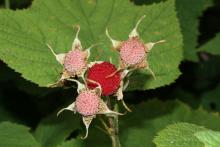
Image Credit: Walter Siegmund
Common name(s): thimbleberry, salmonberry, mountain sorrel, Nutka-Himbeere (German)
General bloom time: flowers in early summer; fruit in late summer
Identification: can grow upwards of 10 feet
Leaves: simple, maple-shaped, deciduous, large (3 to 10 inches in diameter), lobed (3-5 lobes) leaves; dark green in color and velvety on both sides
Flowers: large (1 inch in diameter) white petals with a texture “like crinkled tissue paper” occurring terminally, either as singles or in small clusters
Fruit: small, edible fruits, similar in size and appearance to raspberries
Habitat: wooded forestland
Ecology: Quail, grouse, partridge, thrushes, thrashers, towhees, cardinals and grosbeaks are just some of the birds that feed on the ripe berries. But competition for the berries is stiff! Bears, coyotes, raccoons, squirrels, foxes, opossums and skunks are also very fond of the juicy little treasures. Factor in the lower level browsers–the voles, rabbits, porcupines and beavers--and the taller mammals–including deer, feed on the twigs, buds and leaves.
/index.jpg?itok=L-9rgbRO)
Fun Facts:
- Reproduce both with and without seeds
Places to find in Portland: Forest Park